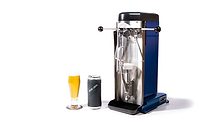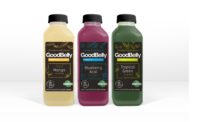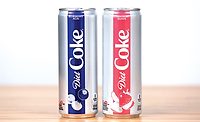Diet Drinks Go ‘Plus’-Sized
By SARAH THEODORE
Functional ingredients add value to weight management products
Diet beverages used to be
distinguished by their lack of calories, but these days simply being
calorie-free doesn’t appear to be enough. Consumers are looking for
functionality, and beverage-makers are adding ingredients to diet drinks
that are intended to aid weight loss or add nutritional value. Last fall,
The Coca-Cola Co. and Nestle launched Enviga, a calorie-burning beverage
containing green tea extracts, calcium and caffeine. Coca-Cola also is
getting ready to roll out Diet Coke Plus, a vitamin-enhanced version of
Diet Coke, while Pepsi plans to launch Tava, a carbonated beverage said to
contain B vitamins, chromium and vitamin E. In June, the company also will
release Diet Pepsi Max with ginseng and extra caffeine.
“The biggest trend that we’re seeing is
the growth in functional foods and beverages to address weight loss or
weight management,” says Robin Steagall, a registered dietician and
manager of nutrition communication for the Calorie Control Council, based
in Atlanta.
“We live in this very multitasking society and
the growth in functional foods just points to the fact that not only are we
multitasking in our lives, but we’re expecting our foods to be
multitasking as well,” she adds.
The market for sugar-free beverages and food in the
United States is estimated to be nearly $6.7 billion this year through
food, drug and mass merchandise retail outlets, according to Mintel
International. By 2010, Mintel estimates it will be worth $7.7 billion. The
bulk of those products are sugar-free carbonated beverages, which are
expected to be worth a little more than $5 billion this year, and almost $6
billion by 2010.
Diet CSDs fared better in 2006 than their full-calorie
counterparts, but sales for most of the major brands — with the
exception of Diet Dr Pepper, which posted a 2.1 percent gain — were
down. That, combined with the success of new age functional beverages such
as SoBe, Fuze and Vitaminwater, perhaps has provided the impetus for the
wave of diet “plus” products hitting the market this spring.
Celsius from Elite FX, Delray Beach, Fla., kicked off
the calorie-burning quest in 2005, with its combination of green tea
extract, caffeine, chromium, glucuronolactone, ginger extract and a range
of vitamins. The product is said to raise the metabolism by an average of
12 percent for up to three hours, and it launched the category that now
includes Enviga, which claims that three cans per day can help the average
person burn an additional 106 calories.
"Enviga increases calorie burning. It represents
the perfect partnership of science and nature," said Rhona Applebaum,
chief scientist at The Coca-Cola Co., in a statement about the product.
"Enviga contains the optimum blend of green tea extracts (EGCG),
caffeine and naturally active plant micronutrients designed to work with
your body to increase calorie burning, thus creating a negative calorie
effect. It makes this product stand out as unique. Enviga brings the
benefits of green tea to the forefront in a convenient and accessible,
great-tasting beverage."
With the addition of Enviga and Diet Coke Plus, as
well as the success of Coke Zero, Coca-Cola is focusing a great deal on
diet drinks these days. The company has said Coke Zero was one of its most
successful product launches as the brand picked up 0.8 percent market share
in its first year. That might not seem substantial, but it gives it a
bigger share of market than much older drinks such as Diet 7 UP.
Coke Zero was developed to expand diet beverages to
“non-diet” consumers and was formulated with a blend of
aspartame and acesulfame potassium.
| Projected sales of sugar-free food and beverages | ||
Sales at current prices | ||
| Year | ($ millions) | % change |
| 2007 | $6,668 | 5.2% |
| 2008 | $7,016 | 5.2% |
| 2009 | $7,369 | 5.0% |
| 2010 | $7,714 | 4.7% |
| Source: Mintel International, forecast of total U.S. food, drug and mass merchandise sales. | ||
“Consumers of diet products traditionally were
women, and beverage-makers are wanting to get
out there and grab other segments like young men and Hispanic
populations,” Steagall says. “In those groups, there is more of
a stigma with the diet label. What you’re seeing is a change in
marketing. These are populations that have the same concerns about weight
loss but they don’t want to look like they’re actively trying
to lose weight. So [beverage companies] are having to do a little
remarketing and rebranding to reach out to additional consumers.”
Another product about to enter the Coca-Cola stable is
Fuze. The company received regulatory approval last month to acquire Fuze
Beverages, based in Englewood, N.J., with its lineup of products that
include Tea, Slenderize, Refresh, and Vitalize beverages. The Slenderize
platform contains six flavors that incorporate InterHealth Nutraceuticals
Inc.’s Super CitriMax and ChromeMate ingredients, both of which are
intended to aid weight control. Super CitriMax is a
calcium/potassium-hydroxycitric acid derived from the Garcinia Cambogia
fruit and is used to control appetite and help burn fat. ChromeMate is a
niacin-bound chromium complex that is intended to promote proper insulin
function, maintain healthy blood sugar and promote lean body mass. Both
ingredients have been available in supplement form for many years, and more
recently have been added to products such as Fuze, PepsiCo’s SoBe
Lean and Ardea Beverages’ Slender Airforce Nutrisoda.
InterHealth Chief Executive Officer Paul Dijkstra says
the Benicia, Calif.-based company chose to get into beverage and food
products because it felt functional products are an effective way to reach
consumers. “I believe you have a market that is hungry for products
that address the weight issues of the world,” he says.
“It’s the next step in diet drinks. ‘No-carb’ or
‘no-sugar’ is what you’ve seen on a lot of products
— this is the next step.”
Dijkstra says the GRAS-certified ingredients have the
potential to be used in a range of food and beverage products, including
dairy and powdered drinks. The company, however, has expressed concern that
consumers might think its products were lumped in with the Federal Trade
Commission’s action earlier this year against alleged deceptive
marketing practices in weight-loss products. It is quick to point out that
its ingredients were not part of the FTC’s action, and Dijkstra says,
“The reason we feel so comfortable about our products is that they
have been on the market for some time and proven to be safe and effective.
We feel very comfortable that both Super CitriMax and ChromeMate have all
the research and all those years of use to get into that space.”
Sweetener options
On the sweetener side, aspartame, produced by
companies such as Ajinomoto and The NutraSweet Co., is still the granddaddy
of high-intensity sweeteners, used in an estimated 6,000 low-calorie
products worldwide.
Splenda brand sucralose, from London’s Tate
& Lyle, had been facing more demand than it had the capacity to meet,
but last year the company brought new production online in Alabama and has
commissioned a new plant in Singapore. In a financial statement earlier
this year, the company said it plans to put additional emphasis behind the
U.S. soft drink market where it hoped to see increased sales of Splenda.
Acesulfame potassium, or Ace-K, from Nutrinova rounds
out the top sweeteners used in diet beverages. Nutrinova has long touted
the blendability of Ace-K to customize flavor options, and aspartame,
sucralose and acesulfame potassium often are blended to achieve unique
flavors and sweetness profiles.
| Projected sales of sugar-free carbonated beverages | ||
Sales at current prices |
||
| Year | ($ millions) | % change |
| 2007 | $5,226 | 4.6% |
| 2008 | $5,470 | 4.7% |
| 2009 | $5,718 | 4.5% |
| 2010 | $5,960 | 4.2% |
| Source: Mintel International, forecast of total U.S. food, drug and mass merchandise sales. | ||
During last fall’s InterBev show, the American
Beverage Association released results of a survey conducted by Public
Opinion Strategies that indicates women are more aware of sugar substitutes
than men. It also found that consumers respond favorably to the terms
“sugar substitute” or “low-calorie sweetener,” but
the term “artificial sweetener” has negative connotations. The
language used to convey a product’s message plays a significant part
in how consumers feel about a sweetened beverage. Consumers with weight
control problems specifically look for
low-calorie references, while those who avoid sugar due to diabetes or
other health concerns look for “sugar substitute” language.
Not all weight-control products are calorie-free
though, and in addition to offering Splenda as a zero-calorie sweetener,
Tate & Lyle has what it calls its Rebalance systems to optimize
sweeteners. The systems are designed to significantly reduce sugar content
while offering a natural sweetness profile.
The company says the Rebalance systems can be used to
develop full-calorie mouthfeel at no-calorie or mid-calorie levels using
other ingredients such as maltodextrin, starches and gums, and can be used
in carbonated beverages, juice drinks, fitness and sports drinks, energy
drinks, and soy and dairy drinks.
Palatnit of America, Morris Plains, N.J., offers a
sweetener that has the same number of calories as sugar, but is digested
more slowly in the body, helping regulate blood sugar levels, which in
theory, helps prevent overeating. Palatinose isomaltulose is derived from
beet sugar but is digested at a rate that provides a low glycemic or low
insulinemic response in the body.
“Palatinit sees great potential for market
success for Palatinose in ready-to-drink and powdered slimming and
breakfast drinks, as well as dairy drinks and smoothies. Here, the
prolonged energy supply and low GI [glycemic index] are helpful benefits
for those living on a weight-controlling diet,” says Debra Bryant,
director of business development and technical services at Palatnit.
Bryant says potential labeling for a product
containing Palatinose could refer to “low GI” or
“prolonged energy release.”
Cargill, Minneapolis, also offers a line of slowly
digestible sweeteners under the Xtend brand name. Xtend Sucromalt is a
slow-release carbohydrate that is digested at a slower rate than sugar to
avoid spikes in blood sugar. It is available in a syrup format and can be
used in products that traditionally would use high fructose corn syrup.
Xtend Isomaltulose is made from sucrose but has 40 to 50 percent the
sweetness of sugar. The company also offers Ascend trehalose, a sugar made
from starch, as well as erythritol, a no-calorie bulk sweetener.
Erythritol, which also is produced by companies such
as Jungbunzlauer and Ventana Health Inc.,
which offers Zsweet, can be labeled as natural, and that is a benefit given
the growth in natural and organic products. The search for a low-calorie or zero-calorie sweetener that can be
classified as natural and accepted by the natural and organic audience has
grown intense. Pepsi-Cola North America
President and Chief Executive Officer Dawn Hudson recently told The New York Times such a
sweetener was considered the “holy
grail,” but that it had to taste great to compete with sweeteners already in use.
The range of potential weight control products is
widening — whether consumers choose traditional sugar-free beverages,
the new breed of functional diet drinks, or full-calorie drinks with a low
glycemic response — because there currently is no stand-out diet
trend that has weight-loss seekers jumping on a bandwagon. In fact, more
than 80 percent of dieters are do-it-yourselfers, the Calorie Control
Council’s Steagall says.
“The trend is the fact that there is no trend
or that people are recognizing that these fad diets do not work for the
long term,” she says. “Consumers are very savvy. There is some
burnout on the claims that people are going to lose weight by eliminating
entire food groups … People get frustrated because you end up with
that yo-yo diet syndrome. What we’re noticing is the trend toward
consumers developing their own solution.
“The good news about that is that people tend to
see more success and are able to stick with it longer if it is something
they have custom designed,” she adds. “In my opinion as a
dietician, I think that’s very positive. Most people, when they go on
their own diet, know what they can give up and what they can live with, and
they tend to be most successful.”





